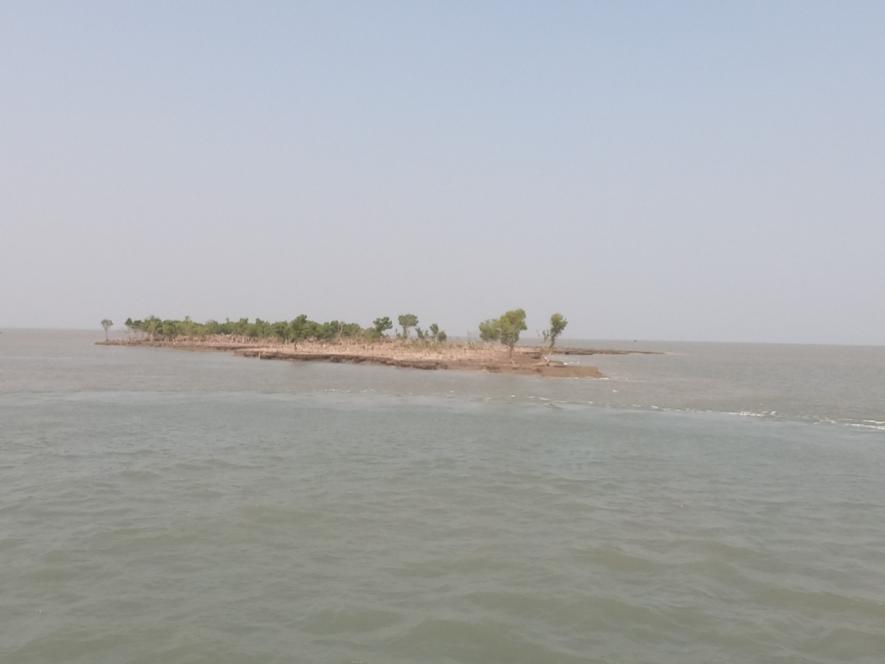Vanishing Island, Belated Action, Sinking Wildlife Sanctuary

A view of the southern side of the fast-vanishing Haliday Island Wildlife Sanctuary. Picture credit: Punarbasu Chaudhuri.
New Delhi: Amid scathing judicial criticism over its failure to protect India’s natural resources, the Central government has declared an eco-sensitive zone around a rapidly vanishing protected island — the Haliday Island Wildlife Sanctuary, which has now reduced to less than 1% of its original size. According to officials, the island – rapidly sinking under the sea – now supports only a sparse remnant of its original flora and fauna and faces imminent extinction.
Haliday Island, an uninhabited island, is in the middle of the Matla River in the Sundarbans in West Bengal’s South 24 Parganas district. It is among hundreds of islands scattered across a complex network of rivers, rivulets and creeks in the Ganges-Brahmaputra delta on the Bay of Bengal, spanning India and Bangladesh.
On May 14, nearly 50 years after Haliday Island was declared a wildlife sanctuary, the Union Ministry of Environment, Forests & Climate Change (“the ministry”) notified a 2-kilometre-radius eco-sensitive zone (ESZ) around it. An ESZ is a designated buffer area meant to protect fragile ecosystems by regulating human activities in the vicinity of protected areas. However, according to forest department officials of West Bengal, no human or industrial activities of any nature are planned in or around Haliday Island.
“The island is deep within the Sundarbans. It is difficult to access and therefore has no human activities in or around it. It is shrinking rapidly. Vegetation over the island is sparse and wildlife is almost non-existent,” Nisha Goswami, the Divisional Forest Officer of South 24 Parganas, said in response to a query by this correspondent.
In a report in November 2022, Newsclick had highlighted how the island was rapidly being engulfed by water without any action plan by the government to save it. This news report was based on research by the public interest environmental law group Legal Initiative for Forest & Environment (LIFE). As per its research, only four hectares (0.04 sq km) – of the 595 hectares (5.95 sq km) of the island when it was notified as a wildlife sanctuary in June 1976 – is left.
The Central government’s data on coastal and oceanic islands of the country itself puts the total area of Haliday Island at 28.7 ha (0.287 sq km). This database, which is maintained by the ministry, describes the island as a “marine protected area”, that is, an area identified for protection of threatened marine species.
The gazette notification, however, sticks to the original figure of 5.95 sq km which was the area as measured when the island was notified in 1976. The notification also says that several vulnerable species of flora and fauna are found on the island. These include the Gangetic Dolphin, Estuarine crocodile, Fishing cat, Estuarine otter, Jackal, Chital, Wild pig, Cotton pygmy goose, Common Teal, Pintail, Crested Serpent Eagle, Peregrine Falcon, Long-tailed Nightjar, Ganges Shark, Hammer head Shark, Guitar Fish, Butter Fish, Gangetic Hairfin Anchovy, Harguza, amur, Lata Sundari, Banjai, Math Goran, Kripe and so on.
The notification further lists out a set of activities to be undertaken by the state government to ensure that the ESZ remains protected.
As per officials of West Bengal forest department, the island’s history dates to the 8th century when it was known as Jinjir. It is believed to have been a possible stopover point on the maritime trade route between India and the Arab countries. It was renamed Haliday Island after Bengal’s first lieutenant governor Sir Frederick James Halliday in the 19th century. The British used the island as a game sanctuary and hunting ground.
The island is part of the Sundarbans Biosphere Reserve, which was identified as a UNESCO World Heritage Site in 2001. Newsclick had also reported that no study, whatsoever, was ever undertaken to determine the island’s rapid submergence.
“The reason behind the island’s submergence could be coastal erosion or sea level rise owing to global warming. Only a detailed scientific analysis could possibly arrive at the reason as to why the island is shrinking. It is in an area frequented by extreme climatic disturbances. However, the ministry’s decision to notify an eco-sensitive zone around the island at a stage when it is facing extinction seems perfunctory and an exercise in futility,” LIFE co-founder Ritwick Dutta told this correspondent.
Instances of submergence of small islands are not very rare. In 2021, the Megapode Wildlife Sanctuary in the Andaman & Nicobar Islands was de-notified by the Central government following its complete submergence under the Bay of Bengal in the Boxing Day Tsunami of December 2004.
In a written response to the Rajya Sabha in December 2021, the ministry had informed that as many as four other protected areas have also been de-notified in the country since 2007 owing to a variety of reasons including lack of flora and fauna or for takeover of land by local communities for farming. These include three protected areas in Haryana – Saraswati Wildlife Sanctuary (de-notified in 2007), Bir Bara Ban Jind Wildlife Sanctuary (de-notified in 2007) and Abubshehar Wildlife Sanctuary (de-notified in 2018). The Kachhua Wildlife Sanctuary in Uttar Pradesh was de-notified in 2020.
The notification of an ESZ around Haliday Island Wildlife Sanctuary comes at a time when the Supreme Court has strongly censured the government for its failure to safeguard the nation’s forests. The apex court, in its recent judgements has pointed out at a nexus between bureaucrats, politicians and builders that has been behind the systemic degradation of the nation’s forests.
On May 16, a division bench of the Supreme Court comprising Justices Abhay S. Oka and Ujwal Bhuyan restrained the government from providing post facto environmental clearances to all categories of projects. The bench set aside a set of office memoranda and notifications, which had been issued in the past by the ministry to provide a backdoor method for project proponents to obtain environmental clearance after beginning construction work or operationalising their projects.
The bench said in its order:
“There are no equities in favor of those who committed gross illegalities without obtaining prior ECs. The persons who acted without ECs were not illiterate persons. They are companies, real estate developers, public sector undertakings, mining industries etc. They were the persons who knowingly committed the illegalities.”
A day earlier, that is, on May 15, a three-judge bench of the Supreme Court, headed by the Chief Justice of India BR Gavai, had quashed the allotment of 11.98 hectares of Reserve Forest land, in Kondhwa Budruk village of Maharashtra’s Pune district, to a private family. The court found that in August 1998, the parcel of Reserved Forest had been allotted to the private family by the revenue department of Maharashtra bypassing the Forest (Conservation) Act, 1980. The family had later sold the land parcel to a housing society.
“The present matter is a classic example as to how the nexus between the politicians, bureaucrats and the builders can result in the conversion of precious forest land for commercial purposes under the garb of resettlement of people belonging to the backward class from whose ancestors, agricultural land was acquired for public purpose,” the bench stated in its judgement.
While disposing of the matter, the apex court also issued a pan-India direction for constitution of Special Investigation Teams (SITs) across all states and Union territories to identify instances of diversion, if any, of forest land, in the possession of revenue departments, for non-forestry purposes.
Investigations are likely to open various cans of worms across the country in so far as the lacunae of various governments in conserving protected areas and reserved forests is concerned.
Inordinate delays by ministries in notifying ESZ buffers around protected areas has resulted in large-scale development of infrastructure, industries and mining projects near protected areas. There has also been confusion about the exact boundaries of buffer zones of protected areas in several instances resulting in illegal land takeover.
For example, numerous instances of encroachments in the core and buffer areas of the Shettihalli Wildlife Sanctuary in Shivamogga district of Karnataka have been reported owing to errors in the demarcation of its boundaries. Non-forestry activities continue to take place in and around the wildlife sanctuary even as the state government and the central government are yet to redraw its boundaries. The draft notification for the wildlife sanctuary was issued in 1974 – more than 50 years ago – and the final notification came in 1977. There is no notification of its ESZ yet. It has been alleged that a large part of land was erroneously included within the boundary of the sanctuary after the final notification, an error which is yet to be rectified.
Similarly, enquiries made by environmental activists through the Right to Information (RTI) Act, 2005 have revealed that large parts of Itanagar city, the state capital of Arunachal Pradesh, have illegally sprung up within the protected area of the Itanagar Wildlife Sanctuary.
The illegal constructions include the state secretariat building and the state legislative Assembly building of Arunachal Pradesh. The building that houses the municipal corporation of Itanagar city has also been illegally constructed within the wildlife sanctuary.
The RTI query was filed by an activist SD Loda. The state government responded with the information that since 1980 no clearance has been granted for any construction activity within the protected boundaries of the wildlife sanctuary as mandated under the Wildlife (Protection) Act, 1972. The wildlife sanctuary had been notified in February 1978.
The writer is an independent journalist.
Get the latest reports & analysis with people's perspective on Protests, movements & deep analytical videos, discussions of the current affairs in your Telegram app. Subscribe to NewsClick's Telegram channel & get Real-Time updates on stories, as they get published on our website.























